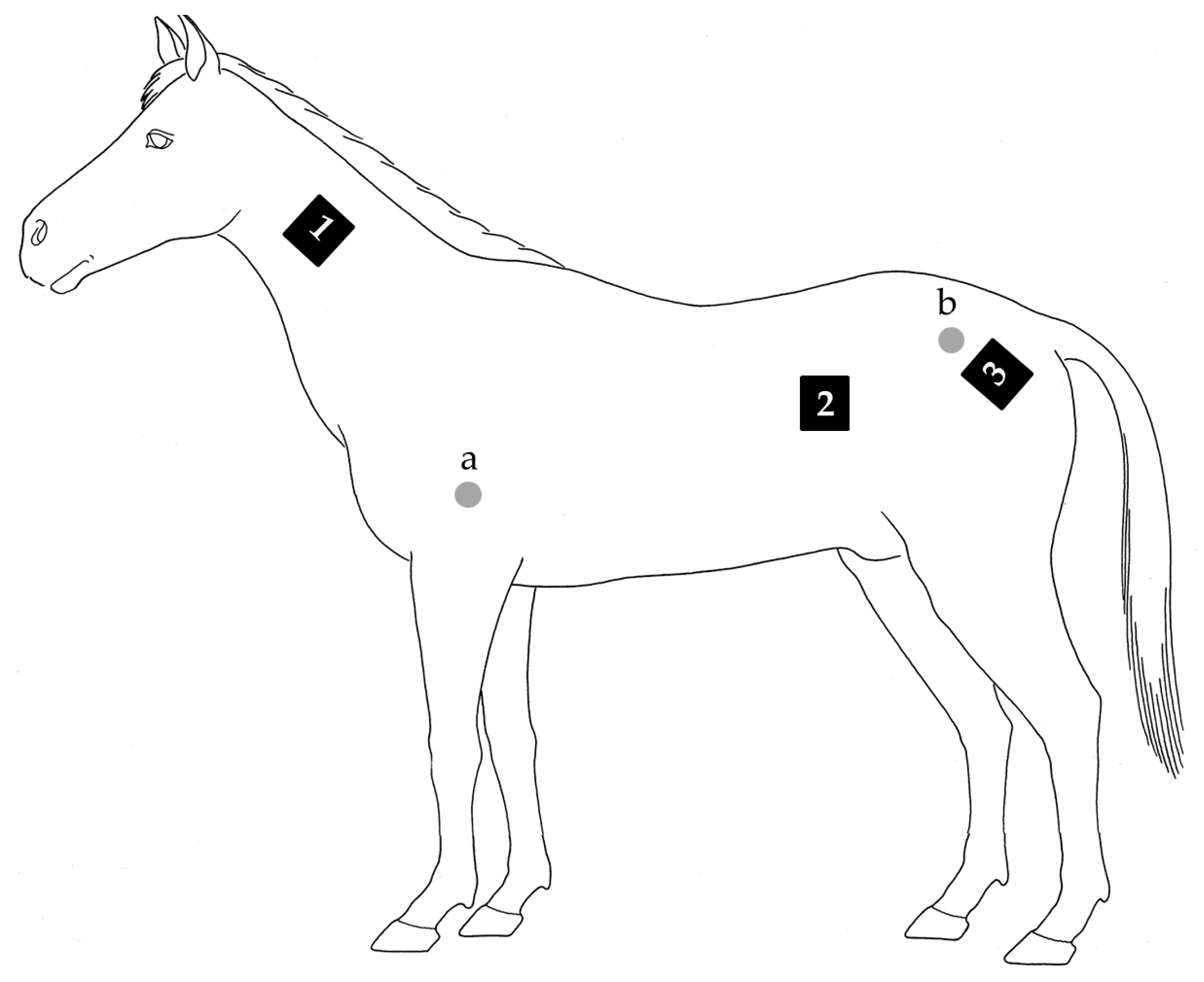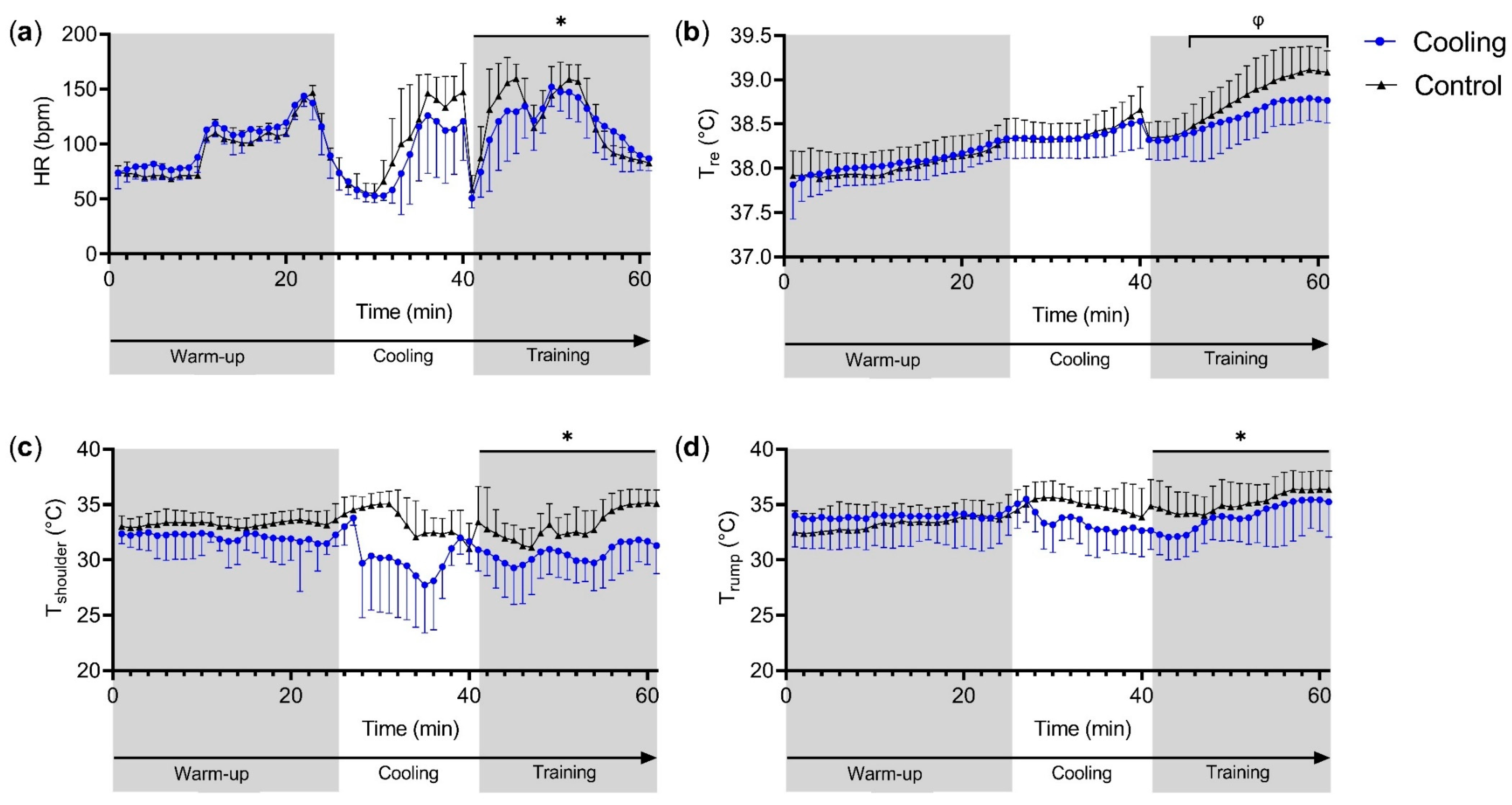Effects of Pre-Cooling on Thermophysiological Responses in Elite Eventing Horses
Simple Summary
Abstract
1. Introduction
2. Materials and Methods
2.1. Participants
2.2. Design
2.3. Measurements
2.4. Statistical Methods
3. Results
3.1. Heart Rate
3.2. Rectal Temperature
3.3. Shoulder Skin Temperature
3.4. Rump Skin Temperature
3.5. Plasma Lactate
3.6. Sweating Response
4. Discussion
4.1. Testing Day
4.2. Thermophysiological Responses
4.3. Exceptional Individual Responses
4.4. Limitations
5. Conclusions
Supplementary Materials
Author Contributions
Funding
Acknowledgments
Conflicts of Interest
References
- Hodgson, D.; McCutcheon, L.J.; Byrd, S.K.; Brown, W.S.; Bayly, W.; Brengelmann, G.; Gollnick, P. Dissipation of metabolic heat in the horse during exercise. J. Appl. Physiol. 1993, 74, 1161–1170. [Google Scholar] [CrossRef] [PubMed]
- Marlin, D.J.; Harris, P.A.; Schroter, R.C.; Harris, R.C.; Roberts, C.A.; Scott, C.M.; Orme, C.E.; Dunnett, M.; Dyson, S.J.; Barrelet, F.; et al. Physiological, metabolic and biochemical responses of horses competing in the speed and endurance phase of a CCI*****3-day-event. Equine Vet. J. Suppl. 1995, 27, 37–46. [Google Scholar] [CrossRef] [PubMed]
- McCutcheon, L.J.; Geor, R.J. Thermoregulation and exercise-associated heat stress. In Equine Exercise Physiology, 1st ed.; Saunders: Philadelphia, PA, USA, 2008; pp. 382–396. [Google Scholar]
- Geor, R.J.; McCutcheon, L.J.; Ecker, G.L.; Lindinger, M.I. Heat storage in horses during submaximal exercise before and after humid heat acclimation. J. Appl. Physiol. (1985) 2000, 89, 2283–2293. [Google Scholar] [CrossRef] [PubMed]
- Hodgson, D.R.; Davis, R.E.; McConaghy, F.F. Thermoregulation in the horse in response to exercise. Br. Vet. J. 1994, 150, 219–235. [Google Scholar] [CrossRef]
- Marlin, D.J.; Scott, C.M.; Roberts, C.A.; Casas, I.; Holah, G.; Schroter, R.C. Post exercise changes in compartmental body temperature accompanying intermittent cold water cooling in the hyperthermic horse. Equine Vet. J. 1998, 30, 28–34. [Google Scholar] [CrossRef] [PubMed]
- Hargreaves, M. Physiological limits to exercise performance in the heat. J. Sci. Med. Sport 2008, 11, 66–71. [Google Scholar] [CrossRef] [PubMed]
- Takahashi, Y.; Ohmura, H.; Mukai, K.; Shiose, T.; Takahashi, T. A comparison of 5 cooling methods in hot and humid environments in Thoroughbred horses. J. Equine Vet. Sci. 2020, 91, 103130. [Google Scholar] [CrossRef] [PubMed]
- Williamson, L.; White, S.; Maykuth, P.; Andrews, F.; Sommerdahl, C.; Green, E. Comparison between two post exercise cooling methods. Equine Vet. J. 1995, 27, 337–340. [Google Scholar] [CrossRef]
- Kohn, C.W.; Hinchcliff, K.W.; McKeever, K.H. Evaluation of washing with cold water to facilitate heat dissipation in horses exercised in hot, humid conditions. Am. J. Vet. Res. 1999, 60, 299–305. [Google Scholar]
- Marino, F.E. Methods, advantages, and limitations of body cooling for exercise performance. Br. J. Sports Med. 2002, 36, 89–94. [Google Scholar] [CrossRef]
- Casa, D.J.; McDermott, B.P.; Lee, E.C.; Yeargin, S.W.; Armstrong, L.E.; Maresh, C.M. Cold water immersion: The gold standard for exertional heatstroke treatment. Exerc. Sport Sci. Rev. 2007, 35, 141–149. [Google Scholar] [CrossRef] [PubMed]
- Bongers, C.C.; Hopman, M.T.; Eijsvogels, T.M. Cooling interventions for athletes: An overview of effectiveness, physiological mechanisms, and practical considerations. Temperature 2017, 4, 60–78. [Google Scholar] [CrossRef] [PubMed]
- Serrano, M.; Evans, D.; Hodgson, J. Heart rate and blood lactate responses during exercise in preparation for eventing competition. Equine Vet. J. 2002, 34, 135–139. [Google Scholar] [CrossRef] [PubMed]
- Amory, H.; Art, T.; Linden, A.; Desmecht, D.; Buchet, M.; Lekeux, P. Physiological response to the cross-country phase in eventing horses. J. Equine Vet. Sci. 1993, 13, 646–650. [Google Scholar] [CrossRef]
- Marlin, D.J.; Misheff, M.; Whitehead, P. Optimising Performance in a Challening Climate. In Proceedings of the Fédération Equestre Internationale (FEI) Sports Forum 2018, Lausanne, Switzerland, 26–27 March 2018; pp. 11–24. [Google Scholar]
- McCutcheon, L.J.; Geor, R.J.; Hare, M.J.; Ecker, G.L.; Lindinger, M.I. Sweating rate and sweat composition during exercise and recovery in ambient heat and humidity. Equine Vet. J. Suppl. 1995, 27, 153–157. [Google Scholar] [CrossRef] [PubMed]
- Kingston, J.K.; Geor, R.J.; McCutcheon, L.J. Rate and composition of sweat fluid losses are unaltered by hypohydration during prolonged exercise in horses. J. Appl. Physiol. 1997, 83, 1133–1143. [Google Scholar] [CrossRef] [PubMed]
- Nadel, E.R.; Mitchell, J.W.; Saltin, B.; Stolwijk, J.A. Peripheral modifications to the central drive for sweating. J. Appl. Physiol. 1971, 31, 828–833. [Google Scholar] [CrossRef]
- Wegmann, M.; Faude, O.; Poppendieck, W.; Hecksteden, A.; Frohlich, M.; Meyer, T. Pre-cooling and sports performance: A meta-analytical review. Sports Med. 2012, 42, 545–564. [Google Scholar] [CrossRef]
- Von Elm, E.; Altman, D.G.; Egger, M.; Pocock, S.J.; Gøtzsche, P.C.; Vandenbroucke, J.P. The Strengthening the Reporting of Observational Studies in Epidemiology (STROBE) statement: Guidelines for reporting observational studies. Ann. Intern. Med. 2007, 147, 573–577. [Google Scholar] [CrossRef]
- Munsters, C.C.; van Iwaarden, A.; van Weeren, R.; Sloet van Oldruitenborgh-Oosterbaan, M.M. Exercise testing in Warmblood sport horses under field conditions. Vet. J. 2014, 202, 11–19. [Google Scholar] [CrossRef]
- Morgan, E.K.M. Climatic energy demands of horses. Equine Vet. J. 1995, 18, 4. [Google Scholar] [CrossRef]
- McCutcheon, L.J.; Geor, R.; Hare, M.J.; Kingston, J.K.; Staempfli, H. Sweat composition: Comparison of collection methods and effects of exercise intensity. Equine Vet. J. 1995, 27, 279–284. [Google Scholar] [CrossRef]
- Siegers, E.W.; Sloet van Oldruitenborgh-Oosterbaan, M.M.; Van den Broek, J.; Munsters, C.B.M. Evaluation of three portable lactate-measurement devices in exercising horses. Pferdeheilkunde Equine Med. 2018, 34, 141–144. [Google Scholar] [CrossRef]
- Feng, C.; Wang, H.; Lu, N.; Chen, T.; He, H.; Lu, Y.; Tu, X.M. Log-transformation and its implications for data analysis. Shanghai Arch. Psychiatry 2014, 26, 105–109. [Google Scholar] [CrossRef]
- Lukacs, P.M.; Burnham, K.P.; Anderson, D.R. Model selection bias and Freedman’s paradox. Ann. Inst. Stat. Math. 2010, 62, 117. [Google Scholar] [CrossRef]
- Marlin, D.J.; Scott, C.M.; Schroter, R.C.; Mills, P.C.; Harris, R.C.; Harris, P.A.; Orme, C.E.; Roberts, C.A.; Marr, C.M.; Dyson, S.J.; et al. Physiological responses in nonheat acclimated horses performing treadmill exercise in cool (20 degrees C/40% RH), hot dry (30 degrees C/40% RH) and hot humid (30 degrees C/80% RH) conditions. Equine Vet. J. Suppl. 1996, 70–84. [Google Scholar] [CrossRef] [PubMed]
- McConaghy, F.F.; Hales, J.R.; Rose, R.J.; Hodgson, D.R. Selective brain cooling in the horse during exercise and environmental heat stress. J. Appl. Physiol. (1985) 1995, 79, 1849–1854. [Google Scholar] [CrossRef]
- Takahashi, Y.; Takahashi, T. Risk factors for exertional heat illness in Thoroughbred racehorses in flat races in Japan (2005–2016). Equine Vet. J. 2020, 52, 364–368. [Google Scholar] [CrossRef] [PubMed]
- Hargreaves, B.J.; Kronfeld, D.S.; Naylor, J.R. Ambient temperature and relative humidity influenced packed cell volume, total plasma protein and other variables in horses during an incremental submaximal field exercise test. Equine Vet. J. 1999, 31, 314–318. [Google Scholar] [CrossRef] [PubMed]
- Geor, R.J.; McCutcheon, L.J.; Ecker, G.L.; Lindinger, M.I. Thermal and cardiorespiratory responses of horses to submaximal exercise under hot and humid conditions. Equine Vet. J. Suppl. 1995, 125–132. [Google Scholar] [CrossRef]
- Green, A.R.; Gates, R.S.; Lawrence, L.M. Measurement of horse core body temperature. J. Therm. Biol. 2005, 30, 370–377. [Google Scholar] [CrossRef]
- Piccione, G.; Caola, G.; Refinetti, R. The circadian rhythm of body temperature of the horse. Biol. Rhythm. Res. 2002, 33, 113–119. [Google Scholar] [CrossRef]
- Kohn, C.W.; Hinchcliff, K.W. Physiological responses to the endurance test of a 3-day-event during hot and cool weather. Equine Vet. J. Suppl. 1995, 31–36. [Google Scholar] [CrossRef] [PubMed]
- Minett, G.M.; Duffield, R.; Marino, F.E.; Portus, M. Volume-dependent response of precooling for intermittent-sprint exercise in the heat. Med. Sci. Sports Exerc. 2011, 43, 1760–1769. [Google Scholar] [CrossRef] [PubMed]
- McGowan, C.J.; Pyne, D.B.; Thompson, K.G.; Rattray, B. Warm-Up Strategies for Sport and Exercise: Mechanisms and Applications. Sports Med. 2015, 45, 1523–1546. [Google Scholar] [CrossRef] [PubMed]
- Brinnel, H.; Cabanac, M.; Hales, J. Critical upper levels of body temperature, tissue thermosensitivity and selective brain cooling in hyperthermia. In Proceedings of the CSIRO Division of Animal Production, Sydney, Australia, 27 April–1 May 1987; pp. 209–240. [Google Scholar]
- Nadel, E.R.; Bullard, R.W.; Stolwijk, J.A. Importance of skin temperature in the regulation of sweating. J. Appl. Physiol. 1971, 31, 80–87. [Google Scholar] [CrossRef] [PubMed]
- Corbett, J.; Rendell, R.A.; Massey, H.C.; Costello, J.T.; Tipton, M.J. Inter-individual variation in the adaptive response to heat acclimation. J. Therm. Biol. 2018, 74, 29–36. [Google Scholar] [CrossRef]


| Component | LOD (mmol/L) | CV (%) | Sample Volume (μL) |
|---|---|---|---|
| Sodium | 0.4 | <1.0 | 15 |
| Chloride | 0.4 | <2.2 | 15 |
| Potassium | 0.2 | 1.0–1.3 | 15 |
| Stage | Gait | V (m/s) | |
|---|---|---|---|
| Cooling | Control | ||
| Warm-up | Walk | 1.6 ± 0.2 | 1.6 ± 0.1 |
| Trot | 3.3 ± 0.3 | 3.3 ± 0.3 | |
| Canter | 4.6 ± 1.2 | 4.8 ± 1.4 | |
| Walk | 0.7 ± 0.3 | 0.7 ± 0.4 | |
| Pre-cooling | Yes | No | |
| Canter training | Canter I | 7.0 ± 0.1 | 7.1 ± 0.2 |
| Canter II | 6.8 ± 2.2 | 6.9 ± 0.7 | |
| Recovery | 1.6 ± 0.0 | 1.6 ± 0.1 | |
| Stage | Skin Site | Cooling | Control | ||||||
|---|---|---|---|---|---|---|---|---|---|
| LSR (mL/m2/min) | Sodium (mmol/L) | Chloride (mmol/L) | Potassium (mmol/L) | LSR (mL/m2/min) | Sodium (mmol/L) | Chloride (mmol/L) | Potassium (mmol/L) | ||
| Warming-up | Neck | 7.6 ± 3.3 | 92.0 ± 16.8 | 152.9 ± 28.8 | 65.0 ± 13.9 | 6.8 ± 4.7 | 87.1 ± 34.3 | 148.0 ± 43.6 | 67.7 ± 18.3 |
| Barrel | 5.6 ± 2.6 | 105.1 ± 23.9 | 181.6 ± 41.9 | 57.7 ± 17.5 | 5.2 ± 3.6 | 91.4 ± 21.4 | 150.3 ± 41.5 | 68.6 ± 12.0 | |
| Rump | 5.0 ± 4.8 | 109.0 ± 23.4 | 187.6 ± 32.5 | 76.3 ± 7.4 | 3.7 ± 2.1 | 77.6 ± 40.8 | 153.4 ± 94.0 | 67.3 ± 43.0 | |
| Canter training | Neck | 13.0 ± 3.6 | 99.1 ± 20.8 | 137.8 ± 46.1 | 48.5 ± 18.7 | 14.1 ± 4.7 | 95.1 ± 26.9 | 132.2 ± 43.6 | 45.0 ± 9.0 |
| Barrel | 10.4 ± 3.1 | 89.0 ± 16.7 | 124.1 ± 33.8 | 43.3 ± 15.8 | 12.9 ± 2.7 | 102.8 ± 17.9 | 145.9 ± 26.8 | 51.1 ± 9.5 | |
| Rump | 16.8 ± 7.1 | 77.6 ± 39.3 | 103.6 ± 70.5 | 35.9 ± 29.0 | 15.3 ± 5.0 | 102.8 ± 29.8 | 169.5 ± 46.1 | 66.1 ± 16.1 | |
© 2020 by the authors. Licensee MDPI, Basel, Switzerland. This article is an open access article distributed under the terms and conditions of the Creative Commons Attribution (CC BY) license (http://creativecommons.org/licenses/by/4.0/).
Share and Cite
Klous, L.; Siegers, E.; van den Broek, J.; Folkerts, M.; Gerrett, N.; van Oldruitenborgh-Oosterbaan, M.S.; Munsters, C. Effects of Pre-Cooling on Thermophysiological Responses in Elite Eventing Horses. Animals 2020, 10, 1664. https://doi.org/10.3390/ani10091664
Klous L, Siegers E, van den Broek J, Folkerts M, Gerrett N, van Oldruitenborgh-Oosterbaan MS, Munsters C. Effects of Pre-Cooling on Thermophysiological Responses in Elite Eventing Horses. Animals. 2020; 10(9):1664. https://doi.org/10.3390/ani10091664
Chicago/Turabian StyleKlous, Lisa, Esther Siegers, Jan van den Broek, Mireille Folkerts, Nicola Gerrett, Marianne Sloet van Oldruitenborgh-Oosterbaan, and Carolien Munsters. 2020. "Effects of Pre-Cooling on Thermophysiological Responses in Elite Eventing Horses" Animals 10, no. 9: 1664. https://doi.org/10.3390/ani10091664
APA StyleKlous, L., Siegers, E., van den Broek, J., Folkerts, M., Gerrett, N., van Oldruitenborgh-Oosterbaan, M. S., & Munsters, C. (2020). Effects of Pre-Cooling on Thermophysiological Responses in Elite Eventing Horses. Animals, 10(9), 1664. https://doi.org/10.3390/ani10091664






